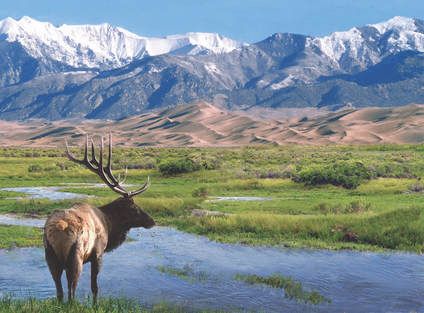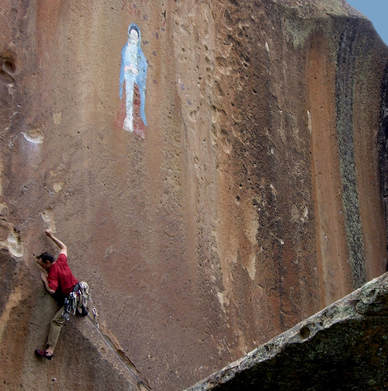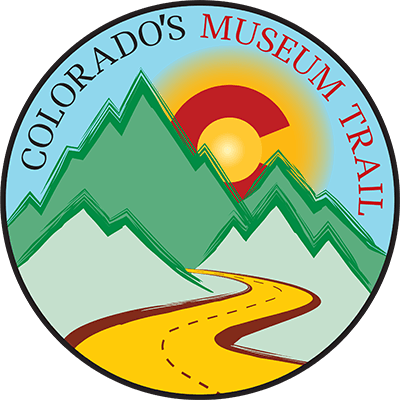Natural Wonders
Flanked by 14,000-foot peaks and towering sand dunes, bisected by the Rio Grande, graced by the seasonal migration of Sandhill cranes, and containing unparalleled opportunities for wilderness exploration, the San Luis Valley possesses incredible natural wonders. Travel mileage: 308+ miles.
Photo above: Sandhill Crane Migration at the Monte Vista National Wildlife Refuge
1 – Cumbres Pass – Cumbres Pass is the southern gateway to the Valley and to Los Caminos Antiguos Scenic and Historic Byway. Cumbres and the nearby La Manga Pass provide access to the Rio Grande National Forest and excellent opportunities for hiking, biking, cross-country skiing and snowmobiling. Forest Service roads branching from Hwy 17 along these passes lead to many trailheads.
2 – Alamosa National Wildlife Refuge – Alamosa NWR contains thousands of acres of wetlands within the floodplain of the Rio Grande. Meadows, river oxbows, and riparian corridors support high species diversity and create ideal conditions for viewing waterfowl, songbirds, and other wildlife. Irrigation canals dating to the 1880s supply much of the refuge’s water. Visitor Center is open March-November. Call
(719) 589-4021 for information.
3 – Blanca Wetlands Wildlife Habitat Area – This area offers ideal habitat for waterfowl and shorebirds not found elsewhere in the SLV or Colorado. Trails weaving between the shallow ponds provide excellent wildlife observation opportunities. 719-852-7074
4 – Zapata Falls Recreation Area – A half-mile hike leads uphill to an intriguing waterfall. Along the trail, hikers enjoy panoramic views of the surrounding country, including the Great Sand Dunes far below. Check out the camping. 719-852-7074
5 – Great Sand Dunes National Park and Preserve –The highest inland dunes in North America appeared as a “sea of sand” to Zebulon Pike in 1807. Prevailing southwest winds sweep up grains of ancient river sands and then deposit them grain upon grain at the base of the Sangre de Cristo Mountains. Two major attractions are “High Dune,” rising 750 feet above the valley floor and Medano Creek, a lazy seasonal stream that pulses with waves during periods of high water. This mosaic of sand, water, and mountains forms one of Colorado’s most distinctive landscapes, now preserved as our newest national park.
Visitor Center hours: Summer – 9 am-6 pm; Spring and Fall – 9 am-5 pm. The Park is open 24hrs of the day, 7 days a week, 365 days of the year.

6 –
San Luis Lakes State Park
– A combination of wetlands, open lakes, and grasslands provide opportunities for outdoor recreation and wildlife viewing. Level hiker/biker trails are suitable for people of all ages and abilities. Other popular pursuits include: water skiing, sailing, fishing, swimming and camping.

7 – Orient Mine, Valley View Hot Springs – Part of the Orient Land Trust, the historic Orient iron mine is home to the largest known colony of bats in Colorado. On the same property, a modest resort and campground has emerged around a series of hot springs with sweeping views of the Valley. Admission to soak in the springs and information about bat viewing opportunities may be obtained at the visitor center. Other historic hot springs are located at Joyful Journey Hot Springs, Sand Dunes Recreation, and Splashland.
Orient Land Trust: 9 am-10 pm daily.
719-256-4315. Reservations are recommended.
Joyful Journey: 9am-10pm.
719-256-4328
Sand Dunes Recreation
719-378-2807
Splashland -
719-589-6258
8 – Poncha Pass – At 9,012 feet, Poncha Pass is the San Luis Valley’s scenic northern entrance. Modern day travelers crossing Poncha Pass enter the Valley via the same route as Native Americans, mountain men, and pioneers. The pass marks the divide between two mighty rivers, the Arkansas and the Rio Grande.
9 – Russell Lakes State Wildlife Area – The ponds and marshes of this wildlife area are legendary among Colorado birders. With its wooden boardwalk, the Johnson Lake nature trail provides year-round opportunities to spot a variety of waterfowl, shorebirds, and raptors. Nearby upland areas are also good for birding.
Most of the wildlife area is closed Feb. 15 to July 15 to protect nesting birds.
Johnson Lake Nature Trail is open year-round.

10 – Penitente Canyon Recreation Area – Years ago, secluded Penitente Canyon was a sacred site for Los Hermanos Penitente, a lay Catholic brotherhood. Today Penitente Canyon is one of Colorado’s premier rock climbing destinations. An attractive campground as well as mountain bike and hiking trails are also located in and around this scenic canyon.
11 – Monte Vista National Wildlife Refuge – The Monte Vista NWR combines with the Alamosa and Baca NWR’s to form the 118,000 acre Alamosa/Monte Vista/Baca National Wildlife Refuge Complex. These create the largest and most diverse collection of wetlands in Colorado. The 14,804-acre Monte Vista Refuge is home to mallards, pintail, teal, American avocets, killdeer, white-faced ibis, egrets, and herons. The annual Monte Vista Crane Festival in March marks the migration of thousands of Sandhill cranes and is an event not to be missed.
The refuge is open during daylight hours, 7 days a week.
12 – Wheeler Geologic Area – The landscape of spires and hoodoos found at the Wheeler Geologic Area is mysterious and wonderful. The unique formations are the result of a tremendous volcanic eruption that occurred about 30 million years ago. Located within the La Garita Wilderness Area, this attraction may be accessed by a rugged 4-wheel drive road or by a 7-mile long hike. An early start or overnight camping is recommended. Directions are available in Creede as well as at the South Fork Visitors Center.
13 – Creede Caldera/Fossil Formations – The only place in the Valley that provides the opportunity to explore fossil remains lies just outside Creede along SH 149. Here, imprints of ancient plants and insects are trapped within the sedimentary shore of the moat that once filled the Creede caldera.



